Consulting

TREE RISK ASSESSMENT
A Tree Risk Assessment (TRA) is a professional evaluation of a tree’s potential to cause harm to people, property, or infrastructure. It involves inspecting the tree and its surroundings to identify risks and recommend mitigation measures.

TREE INVENTORIES & SURVEYS
A tree inventory is a comprehensive, data-driven inventory of all the trees on a property or in a specific area. Detailing key information about each tree, including species, size, location, condition, and maintenance needs.

ISA CERTIFIED & REGISTERED CONSULTING ARBORISTS
Our certified consulting arborists assist in cases involving; property damage from fallen trees or limbs, personal injury due to unsafe conditions, tree ownership and boundary disputes, tree removal or negligence claims, insurance claims and valuation disputes, or land use, zoning, and preservation conflicts.

TREE-RELATED LEGAL DISPUTES
Storm damage, personal injury, or code compliance issues, expert testimony can make or break a case.

TREE APPRAISAL & VALUATION
What’s your tree worth? Our certified consulting arborist can calculate the monetary value of a tree by using CTLA’s Guide for Plant Appraisal and will assess the depreciation and replacement cost.
Cabling & Bracing

TREE SUPPORT SERVICES
Depending on the size of a tree there can be multiple cables in addition to bracing to support the weight. Each tree is different, and not all trees are candidates for tree support systems due to their structure.

STANDARDS BASED
We follow ANSI A300 guidelines and use industry-recommended materials and configurations.

SAFETY-FIRST APPROACH
We only recommend support systems, when necessary, after evaluating all pruning or structural reduction options.

POST STORM ASSESSMENT
It is imperative to have your trees inspected post storm by one of our Certified Arborists to assess your tree’s need for cables and bracing to help protect it from becoming a potential hazard.

SPLIT TRUNK
Split trunks are most often found on multi-trunked trees. As these trees grow, the weight increases and width of their original stems increases growing wider and wider. Eventually, these trunks will start to grow in a way that creates internal pressure along the joint at the base of the tree.
Tree Inventories

DOCUMENTATION OF SPECIES, SIZE, LOCATION, & CONDITION
Conducted by ISA-certified arborist, a tree inventory goes beyond a visual check to identify species, size, location, and condition of each tree.
Expert Witness Testimony

CASE ANALYSIS & INVESTIGATION
Our certified consulting arborist assists in cases involving property damage from fallen trees or limbs, personal injury, tree ownership and boundary disputes.
Tree Survey

SURVEY LEVEL DATA OF PROTECTED TREES
Local regulations require tree survey data prior to construction. Understanding this process will save you time and money during the development process.

GIS SPATIAL ACCURACY & MAPPING
Our surveys utilize advanced GIS technology to accurately and precisely map the location of every protected tree on a property, ensuring reliable data for planning and compliance.

MEET LOCAL CODE & ORDINANCE RESTRICTIONS
Our team of consulting arborists is well-versed in municipal regulations and tree preservation ordinances. We ensure every tree survey is accurate, compliant, and submitted correctly the first time—streamlining the approval process and avoiding costly delays.
Tree Assessment

PREVENT PROPERTY DAMAGE
Unstable or unhealthy trees can fall without warning—especially during storms. Identifying risks early helps prevent damage to homes, vehicles, and nearby structures.

HEALTH & STRUCTURAL EVALUATION
Our certified arborists take a closer look at the tree’s trunk, branches, and foliage. Using advanced tools when necessary, we check for internal decay, fungal growth, pest infestations, root integrity, and more.
Tree Planting
We Love Trees
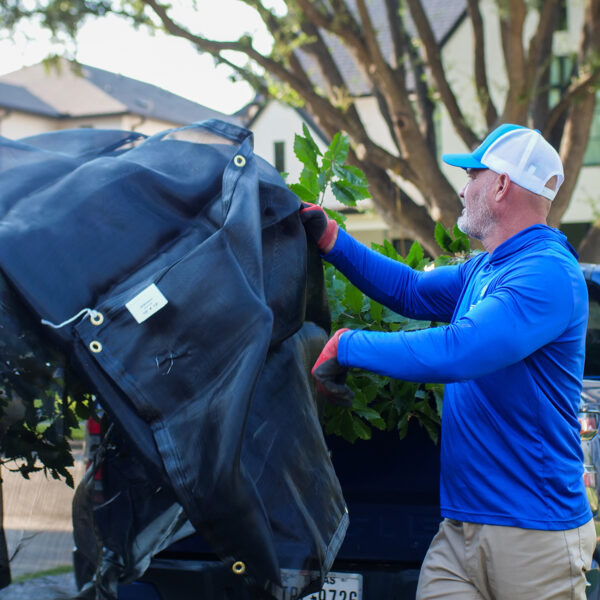
EXPERT KNOWLEDGE AND SKILLSET
We begin by choosing the best trees. Every tree is inspected closely by our arborists to ensure the best stock is installed at your property.

CUSTOMIZED PLANNING FOR YOUR LANDSCAPE
Prior to planting your new tree an arborist will work with you to find the best location on your property to optimize tree health and growth once installed. Depending on the size of the tree and how long ago the tree was removed from a spot will determine if that location can be used to replant.
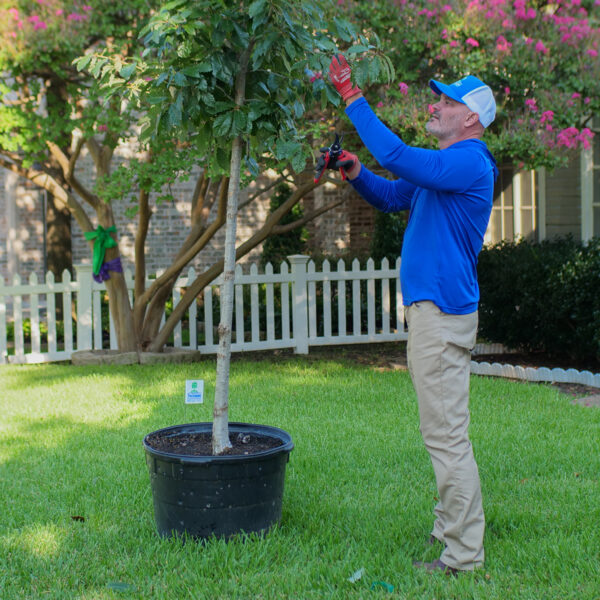
ENCOURAGING HEALTHY DEVELOPMENT
If needed, we will do structural pruning to ensure your tree grows beautifully. Prior to arrival we ensure all trees that are selected have healthy dominate stems.

PROPER PLANTING TECHNIQUES
The key to successful tree planting starts from the ground up. Digging the right hole is essential for the tree's success—it's not too deep and wide enough to support proper root growth.
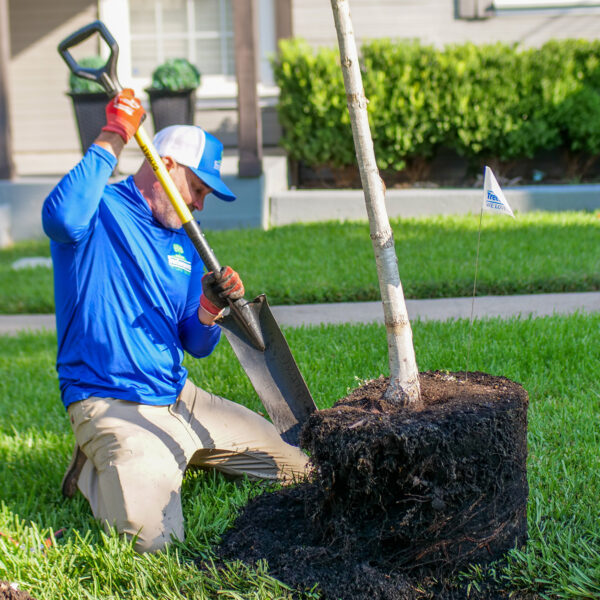
BREAKING APART ROOT BALL
It may look alarming but it is important to break apart the root ball so the roots are able to grow outwards instead of wrapping around itself. Their roots have been bound in a container for a long time and need to be trained to grow outward.
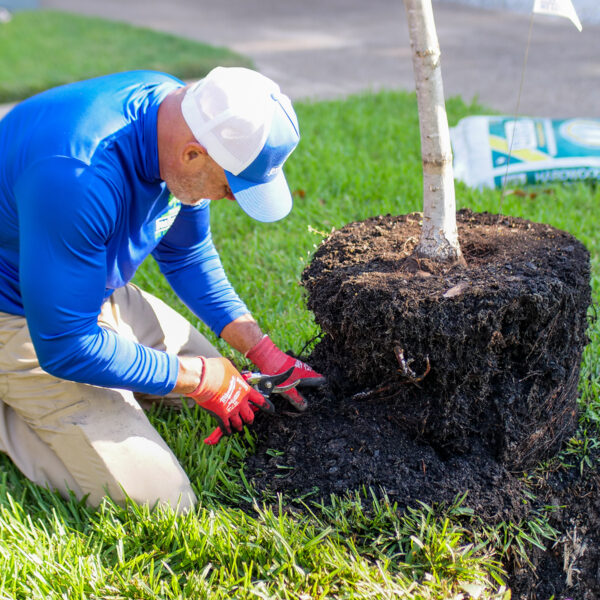
ROOT PRUNING
Root pruning is essential in establishing healthy roots when planting trees. Removing problematic girdling roots ensures healthy trees from the ground up.
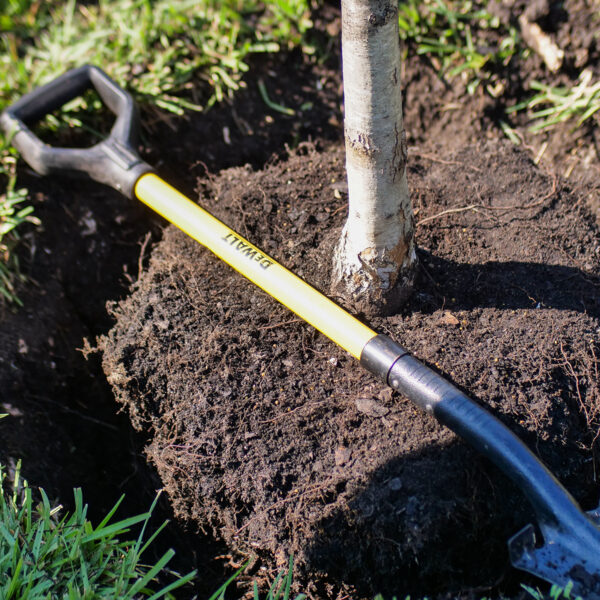
PROPER HOLE DEPTH AND WIDTH
We plant the tree in the ground and take great care to ensure that the tree is at the correct depth and is straight.

BACKFILL WITH SOIL & WATER
Now that the tree has been installed we backfill with water to help the soil settle and secure the tree's roots into the ground. If the tree is properly planted there will not be a need for stakes to keep it in place.

MULCH
Our crew will then mulch the tree, making sure to create a bowl shape to protect the base. Be careful not to let the mulch pile up around the trunk, as it can harm the tree and void the warranty.

PROPER WATERING TECHNIQUE
Before leaving we do one more final soaking once the tree has been planted. We will also leave a detailed care guide and a 5 gallon blue bucket with soaker holes to help you water your tree properly. Watering your tree with two buckets full every other day for the first two weeks will set your tree up for long-term growth.
Arborist Services
View Photos of our Arborists Providing Different Types of Consultation

INSURED AND BONDED
Our crews work together to come up with the best plan to safely remove trees from a site. All of our employees train under a Certified Arborist to ensure best practices are always followed.

ISA CERTIFIED ARBORIST
Certified Arborist are tree care professionals who have achieved a high level of professional distinction through their knowledge and experience in the field. This knowledge helps them diagnose any issues your trees might be having.

BEST TIME TO TRIM
Best practice is to trim certain trees during dormant periods, making fall and winter generally the best time. To learn more about best practices for when you should trim your tree click here.

DIAGNOSING TREE
Our ISA Certified Arborists use several different types of tools to help them assess a trees health. The arborist is "sounding" the tree. Different sounds can indicate areas of decay or other defects.

CONSTRUCTION PROTECTION
Construction is the most common cause of tree death in urban environments. Under the supervision of a Certified Arborist in the planning phase of construction can help assess the potential impact to your trees and suggest modifications in plans when possible. One helpful action is to erect barriers as far from the base of the trunk as possible, or a minimum of the drip line.

DIAGNOSING COMPACTION
Our ISA Certified Arborists can assess your property for tree care issues including compaction and recommend a course of action to remedy the issues. Diagnosing compaction involves an understanding of local soil types, property information related to activities affecting the soils, as well as a thorough knowledge of tree types and common issues.

FERTILIZATION
Our Tree Health Care Programs are designed to deliver the right nutrients at the right times throughout the year. We use the highest quality soil conditioners and fertilizers that are delivered at critical points throughout the seasons to optimize the growth and health of trees.

AIR SPADING
Air spading helps improve tree health by increasing the tree root's access to air, water, and nutrients by decompacting the soil. Soil compaction occurs in urban environments during turf installation, construction, improper planting, and mechanical and foot traffic.

TREE HEALTH CARE
Director of Tree Health Care Development, Steve Barrett pointing out sections in the tree that need to be addressed for improved health.

INSPECTING FOR POSSIBLE DECAY
Sometimes issues with a tree aren't clearly visible on the outside so an arborist will need to inspect the interior. An arborist does this by probing with a small knife to see how extensive the decay in a region of a tree is. Arborists are able to use this information along with other signs to determine if there are potential structural issues or possible increased chances for failure.

MEASURING DBH
The best way to approximate the size of a tree is to measure their dbh, (diameter, breast, height). This enables our arborists to estimate the amount needed for Tree Health Care products or pricing for Tree Removal.
Tree Removal
View Photos of our Highly Trained Crew's Getting the Job Done

HIGHLY SKILLED CLIMBERS
Our crews are comprised of individuals with different areas of expertise. Our highly skilled climbers use several types of PPE to keep them safe while in the canopies of the trees.

INSURED AND BONDED
Our crews work together to come up with the best plan to safely remove trees from a site. All of our employees train under a Certified Arborist to ensure best practices are always followed.

CLIMBING LINE & DRT
Safety for our climbers and your property is important to us at Texas Tree Surgeons. Our climbers use climbing line (specially designed rope) and use DRT (Double Rope Technique) to help them move safely within the tree canopy.

CRANE TREE REMOVAL
Different problems like cracks, holes, sickness, or rot mean you’ve gotta approach removing the tree differently to stay safe. When a tree is not safe for a climber, the use of cranes and grapple saw trucks are sometimes neccessary . Use of machinery, while likely more expensive, provides huge safety benefits and can significantly reduce risk.

REDUCING RISK & LIABILITY
The use of cranes help arborists lift and maneuver tree sections over obstacles such as houses or power lines, when dealing with dead or weakened trees, significantly reducing the risk of damage and liability. Dead branches and decayed tree structures pose significant safety hazards to climbers and ground crew.

TCIA & ISA GUIDELINES
We strictly adhere to TCIA & ISA guidelines in order to ensure everything we do is safe and in the best interest of your trees. By getting your tree assessed by our team of ISA certified arborists and trimmed by one of our skilled crews is the best way to ensure that your tree lives a long and healthy life.

PROTECTING PROPERTY FROM DAMAGE
Using climbing line to secure branches while trimming is important to keep your property and climbers safe. They are able to control the branches descent and place it gently onto the ground below.

MEASURING DBH
The best way to approximate the size of a tree is to measure their dbh, (diameter, breast, height). This enables our arborists to estimate the amount needed for Tree Health Care products or pricing for Tree Removal.

RIGGING TO SAFELY REMOVE LARGE FALLEN LIMBS
This large red oak had split and fallen over the owners house and into the tree adjacent to it. By using rigging our crews are able to guide large limbs out of precarious locations in a safe and efficient manner.

LARGE LIMB BEING LOWERED
When a tree or large limb is being removed, it is roped off and lowered to the ground so nothing is damaged in the process. Our work is done by trained tree climbers with specialized equipment.

SAFETY FIRST
To ensure a safe work environment groundsmen will clear excess debris intermittently while tree trimming or removal takes place. Clearing the site as the tree is trimmed also ensures jobs are done in a timely manner.

RIGGING IN LARGE TREES
Our crews use ropes designed specifically for tree care because they must be able to withstand friction against the tree and be able to hold hundreds of pounds.

LARGE TREE REMOVAL
We only work with highly skilled teams of climbers and groundsmen who are experienced in technical tree work. In addition Texas Tree Surgeons is insured and bonded for your protection.

ATTENTION TO DETAIL
Our goal when we leave a job site is to leave it looking better than how we found it. That means picking up any debris that were created when trimming or removing a tree.

FULL CLEAN-UP
To ensure a job is completed quickly groundsmen will haul away brush intermittently while trimming or removal happens to keep the site clear and safe to move around. Groundsmen will chip the material on-site as needed to make sure all debris is collected and removed at the end of the job.
Tree Triming
View Photos of our Highly Trained Crew's Getting the Job Done

HIGHLY SKILLED CLIMBERS
Our crews are comprised of individuals with different areas of expertise. Our highly skilled climbers use several types of PPE to keep them safe while in the canopies of the trees.

WHY USE A CRANE FOR TREE REMOVAL
What determines if a crane should be used over climbers is when; root rots such as Ganoderma or Kretzchmaria make the tree weak and structurally unsound, splitting, hornets living inside the hollow, or a tree to far gone from Hypoxylon Canker.

CLIMBING LINE & DRT
Safety for our climbers and your property is important to us at Texas Tree Surgeons. Our climbers use climbing line (specially designed rope) and use DRT (Double Rope Technique) to help them move safely within the tree canopy.

INSURED AND BONDED
Our crews work together to come up with the best plan to safely remove trees from a site. All of our employees train under a Certified Arborist to ensure best practices are always followed.

ARBORIST AND CREW WORKING TOGETHER
We hire only the most experienced climbers to trim trees, and all our employees train under a ISA Certified Arborist.

BEST TIME TO TRIM
Best practice is to trim certain trees during dormant periods, making fall and winter generally the best time. To learn more about best practices for when you should trim your tree click here.

TCIA & ISA GUIDELINES
We strictly adhere to TCIA & ISA guidelines in order to ensure everything we do is safe and in the best interest of your trees. By getting your tree assessed by our team of ISA certified arborists and trimmed by one of our skilled crews is the best way to ensure that your tree lives a long and healthy life.

PROTECTING PROPERTY FROM DAMAGE
Using climbing line to secure branches while trimming is important to keep your property and climbers safe. They are able to control the branches descent and place it gently onto the ground below.

SMALL SPACE WORK
Trimming and removing trees in small spaces takes extra time and extra care. Each piece must be cut and lowered with exact precision to avoid damage to property.

TYING OFF LIMBS FOR SAFETY
When trimming trees over structures, larger limbs need to be tied off so they do not damage the roof or the structure itself.

CRAPE MYRTLE TRIMMING
Crape Myrtles are beautiful and hardy trees when cared for properly; topping Crape Myrtles is a bad practice and not recommended.

SAFETY FIRST
To ensure a safe work environment groundsmen will clear excess debris intermittently while tree trimming or removal takes place. Clearing the site as the tree is trimmed also ensures jobs are done in a timely manner.

THE RIGHT-SIZED CREW FOR EVERY JOB
We work with crews of different sizes to make sure that every job is done safely, quickly, and efficiently.

TREE TRIMMING
Our experienced climbers safely climb into the tree canopies to properly trim branches.

ATTENTION TO DETAIL
Our goal when we leave a job site is to leave it looking better than how we found it. That means picking up any debris that were created when trimming or removing a tree.

FULL CLEAN-UP
To ensure a job is completed quickly groundsmen will haul away brush intermittently while trimming or removal happens to keep the site clear and safe to move around. Groundsmen will chip the material on-site as needed to make sure all debris is collected and removed at the end of the job.
Tree Health Care
View Photos of our ISA Certified Arborists & Tree Health Care Technicians Providing Consultation and Care

TREE SUPPORT SERVICES
Depending on the size of a tree there can be multiple cables in addition to bracing to support the weight. Each tree is different, and not all trees are candidates for tree support systems due to their structure.

ISA CERTIFIED ARBORIST
Certified Arborist are tree care professionals who have achieved a high level of professional distinction through their knowledge and experience in the field. This knowledge helps them diagnose any issues your trees might be having.

PREVENTATIVE EAB TREATMENT
If there is EAB activity within a few miles of where you live or property you manage we recommend preventative systemic insecticide treatment applied by a licensed TDA tree health care technician. EAB treatment lasts for 2 years and must be applied regularly to protect ash trees from infection.

OAK WILT TREATMENT
As oak wilt is a systemic, vascular disease, the most effective treatments consist of injecting the infected trees with a fungicidal chemical. The only currently recommended fungicide is Alamo®, a formulation of the fungicide propiconazole. The fungicide is administered through holes drilled in the root flare of the infected tree and should only be applied by Texas Department of Agriculture Licensed Applicators.

SOIL AMENDMENTS
Our uniquely developed mixtures promote stability and growth for trees efficiently and safely, without the worry of harmful chemicals that some companies use that can be damaging to the surrounding environment.

STRESSED MAGNOLIA | BEFORE
This magnolia tree is one of many that were in decline on a single property. This photo is from April 15, 2024 prior to the tree receiving a tree health care plan.

STRESSED MAGNOLIA | AFTER
This after photo was taken June 27, 2024 of a magnolia tree after receiving multiple interventions to improve its health. In addition to a tree health care plan of a deep root fertilization with Biopack plus and Sea3 applied by our TDA licensed technician the owner also fixed the irrigation and cleared the root flare. The difference in health is beautiful.

TDA LICENSED
Our technicians are TDA licensed and use science based treatment when implementing a Tree Health Care plan. These plans are put in place under the guidance of an ISA Certified Arborist.

DIAGNOSING TREE
Our ISA Certified Arborists use several different types of tools to help them assess a trees health. The arborist is "sounding" the tree. Different sounds can indicate areas of decay or other defects.

FERTILIZATION
Our Tree Health Care Programs are designed to deliver the right nutrients at the right times throughout the year. We use the highest quality soil conditioners and fertilizers that are delivered at critical points throughout the seasons to optimize the growth and health of trees.

DEEP ROOT INJECTION SERVICES
At Texas Tree Surgeons our deep root injection services provides fertilization deep into the soil. Our unique mixtures combine macro- and micro-nutrients, root growth stimulators, soil conditioners, beneficial biotics (both mycorrhizal fungi and rhizobacteria), and organic materials to cultivate the optimum natural growth environment.

AIR SPADING
Air spading helps improve tree health by increasing the tree root's access to air, water, and nutrients by decompacting the soil. Soil compaction occurs in urban environments during turf installation, construction, improper planting, and mechanical and foot traffic.

ROOT PRUNING POST AIR SPADING
To correct this improperly planted tree our Tree Health Care Technicians air spade to expose the root flare and to prune away girdling roots. You can learn more about how to properly plant a tree here.

GIRDLING ROOTS
This tree was planted too deep and has several girdling roots (roots that circle the tree and do no flare out) that left unmanaged would eventually kill the tree. After air spading our Tree Health Care Technicians are pruning the roots and adjusting the soil around the tree to expose the root flare to improve tree health.

TREE HEALTH CARE
Director of Tree Health Care Development, Steve Barrett pointing out sections in the tree that need to be addressed for improved health.

INSPECTING FOR POSSIBLE DECAY
Sometimes issues with a tree aren't clearly visible on the outside so an arborist will need to inspect the interior. An arborist does this by probing with a small knife to see how extensive the decay in a region of a tree is. Arborists are able to use this information along with other signs to determine if there are potential structural issues or possible increased chances for failure.

MEASURING DBH
The best way to approximate the size of a tree is to measure their dbh, (diameter, breast, height). This enables our arborists to estimate the amount needed for Tree Health Care products or pricing for Tree Removal.
Stump Grinding
View Photos of our Highly Trained Crew's Getting the Job Done

STUMP REMOVAL
Our stump grinder drills down to 4-6″ below grade to effectively remove your stump and exposed roots.

BENEFITS OF STUMP REMOVAL
Stump grinding reduces insect activity, mitigates new and unwanted growth, and provides room for future landscaping.

STUMP GRINDING
When the machine has finished grinding, you will be left with a mulch pile where there once was a stump. This mulch pile is often 20-30% larger than the pre-existing stump.

MULCH LEFT AFTER LARGE STUMP GRINDING
Mulch left after stump grinding can be messy but it is also very useful. The mulch left after stump grinding is used to backfill the hole for safety. Left over mulch is also great for use on other trees on your property to help nourish them. Learn more about the benefits of mulch by clicking here.

FULL CLEAN-UP
Our goal after we do any service is leave your yard looking better than how we found it. After a stump has been ground the mulch will be used to back fill the hole. Remaining debris will be swept together in one neat pile. If you need us to remove any excess mulch we can haul it away for an additional fee.
Emergency Tree Work
Photo's documenting emergency tree work due to storms or failure.

HIGHLY SKILLED CLIMBERS
Our crews are comprised of individuals with different areas of expertise. Our highly skilled climbers use several types of PPE to keep them safe while in the canopies of the trees.

INSURED AND BONDED
Our crews work together to come up with the best plan to safely remove trees from a site. All of our employees train under a Certified Arborist to ensure best practices are always followed.

CLIMBING LINE & DRT
Safety for our climbers and your property is important to us at Texas Tree Surgeons. Our climbers use climbing line (specially designed rope) and use DRT (Double Rope Technique) to help them move safely within the tree canopy.

TEAMWORK
Our arborist and foremen work together to ensure work done on your trees is done correctly and safely. Our entire team; arborists, foremen, and groundsmen strictly follow TCIA and ISA guidelines.

RED OAK LIMB SECURED WITH LINE
A customer's red oak tree's limb failed and fell onto the homeowners steel carport. This large limb blocked the driveway and was hanging into the neighbors yard. Raul and his crew worked together to remove the limb safely and quickly without the aide of a crane. Cranes are sometimes used when trees are deemed too unsafe to climb. Issues with cranes is that they require a lost of space and increase the price of tree work.

ACCESSING DAMAGE
Understanding and evaluating weakness in the tree prior to doing emergency tree work is important to know because it will eliminate further risk to property and workers during the process. Trees with different defects need to be removed differently for safety. Our foremen have the expertise in determining if we can safely remove broken limbs or trees without a crane.

CLIMBING LINE & DRT
Safety for our climbers and your property is important to us at Texas Tree Surgeons. When damage has already incurred from limb failure it is important to mitigate further damage. Our climbers use climbing line (specially designed rope) and use DRT (Double Rope Technique) to help them move safely and support broken limbs so they can be safely lowered with control.
Before & After
Photos documenting recent projects from start to finish.

STRESSED LIVE OAK | BEFORE
This live oak is showing signs of stress after construction was completed at the property. Photo of this tree was taken in November 2019 before a Stressed Tree Care Plan was implemented.

STRESSED LIVE OAK | AFTER
This photo was taken in August 2025 after 5 years of being on a Stressed Tree Care Plan.

LIVE OAK TRIM | AFTER
Live Oak has been trimmed to ensure there aren't any branches touching the roof of the neighbors home. Pruning more established trees helps to allow for more light and air to pass through the crown, this can help mitigate any potential storm damage.

STRESSED MAGNOLIA | BEFORE
This magnolia tree is one of many that were in decline on a single property. This photo is from April 15, 2024 prior to the tree receiving a tree health care plan.

STRESSED MAGNOLIA | AFTER
This after photo was taken June 27, 2024 of a magnolia tree after receiving multiple interventions to improve its health. In addition to a tree health care plan of a deep root fertilization with Biopack plus and Sea3 applied by our TDA licensed technician the owner also fixed the irrigation and cleared the root flare. The difference in health is beautiful.

RED OAK REMOVAL | BEFORE
This red oak had a large split in it and needed to be removed due to safety concerns. It had fallen above the home and is also partially resting in the tree adjacent to it. Both trees were planted by the homeowners in 1977.

RED OAK REMOVAL
Our expert climbers use rigging to ensure branches slowly and safely descend to the ground to protect property and to keep everyone on site safe.
Before & After | Tree Health Care
Photos documenting improvement in tree health.

STRESSED LIVE OAK | BEFORE
This live oak is showing signs of stress after construction was completed at the property. Photo of this tree was taken in November 2019 before a Stressed Tree Care Plan was implemented.

STRESSED LIVE OAK | AFTER
This photo was taken in August 2025 after 5 years of being on a Stressed Tree Care Plan.

STRESSED MAGNOLIA | BEFORE
This magnolia tree is one of many that were in decline on a single property. This photo is from April 15, 2024 prior to the tree receiving a tree health care plan.

STRESSED MAGNOLIA | AFTER
This after photo was taken June 27, 2024 of a magnolia tree after receiving multiple interventions to improve its health. In addition to a tree health care plan of a deep root fertilization with Biopack plus and Sea3 applied by our TDA licensed technician the owner also fixed the irrigation and cleared the root flare. The difference in health is beautiful.
Video Gallery
Collection of instructional videos and documentation of recent projects



























